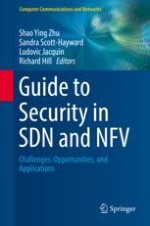This book highlights the importance of security in the design, development and deployment of systems based on Software-Defined Networking (SDN) and Network Functions Virtualization (NFV), together referred to as SDNFV. Presenting a comprehensive guide to the application of security mechanisms in the context of SDNFV, the content spans fundamental theory, practical solutions, and potential applications in future networks.
Topics and features: introduces the key security challenges of SDN, NFV and Cloud Computing, providing a detailed tutorial on NFV security; discusses the issue of trust in SDN/NFV environments, covering roots of trust services, and proposing a technique to evaluate trust by exploiting remote attestation; reviews a range of specific SDNFV security solutions, including a DDoS detection and remediation framework, and a security policy transition framework for SDN; describes the implementation of a virtual home gateway, and a project that combines dynamic security monitoring with big-data analytics to detect network-wide threats; examines the security implications of SDNFV in evolving and future networks, from network-based threats to Industry 4.0 machines, to the security requirements for 5G; investigates security in the Observe, Orient, Decide and Act (OODA) paradigm, and proposes a monitoring solution for a Named Data Networking (NDN) architecture; includes review questions in each chapter, to test the reader’s understanding of each of the key concepts described.
This informative and practical volume is an essential resource for researchers interested in the potential of SDNFV systems to address a broad range of network security challenges. The work will also be of great benefit to practitioners wishing to design secure next-generation communication networks, or to develop new security-related mechanisms for SDNFV systems.
